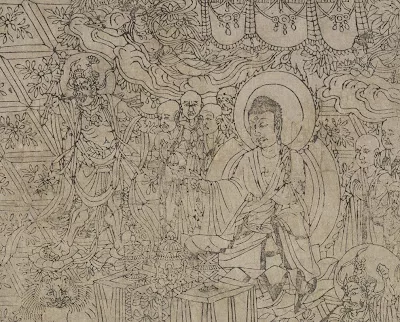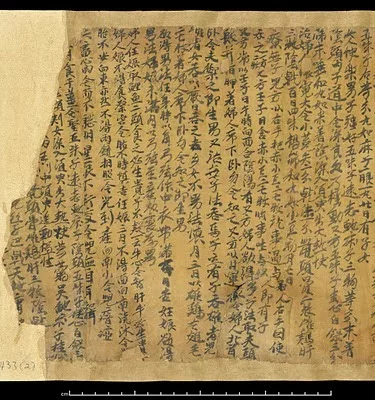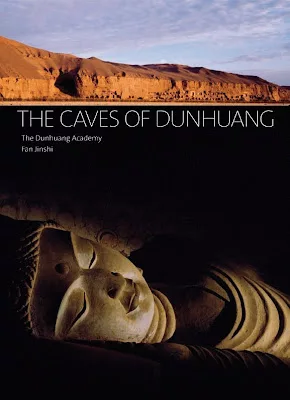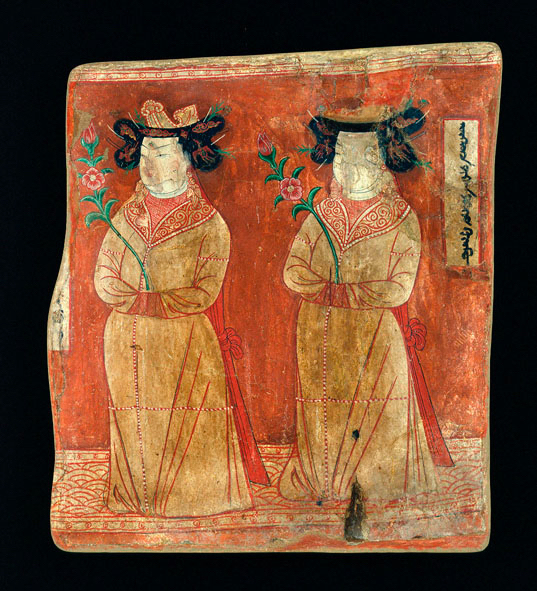A guide to orientating your tomb
Among the manuscripts found in the library cave of the Mogao Grottoes complex, near Dunhuang, there are a number of fascinating divination works. These include the scroll Or.8210/S.3877, recently conserved by colleagues Wong Wing-hui and Vania Assis (see related blog post).

Made of thin yellow paper and written in a rather rough hand, this manuscript was probably intended for personal, rather than more official, use. It includes extracts from different titles, as well as a lay society circular and contracts, some of which are dated from 897, 902 and 909. Its sketches are of particular interest for us as they illustrate a form of divination crucial in ancient China: one that focused on where best to build a tomb.
Geomancy, sometimes referred to as ‘siting’, dictated the positioning of both domestic and funerary structures, from palaces to graves. It led to practices often better-known nowadays under the term fengshui, literally translated as “wind-water” and thought to go back to the Song Dynasty. Its primary focus, nonetheless, remained on the deceased.
The front of scroll Or.8210/S.3877 is entirely filled by a drawing depicting four different topographical configurations. This appears to be a concrete example of how to determine the appropriate location for a funerary site.
First is a group of mounds evoking hills. A patchy inscription, of which only the characters “大吉” (daji) survive, indicates a “very lucky, highly auspicious” spot.
Another caption at the centre of this mountainous formation states that a sepulture positioned there would bring unending riches and honour: “葬得此地,富貴不絕” (zang dei cidi, fugui bujue).
The other three landforms, though not as easily identifiable, are all named as mountain ridges: Baozi Gang (抱子崗), shown in the photograph below, Sangai Shangang (散盖山崗), and Xionglong Shangang (雄龍山崗).
Again, auspicious sites are designated by inscriptions: chu erqian dan 出二千石, lingzhang 令長, chu jiuqing xiang 出九卿相, chu fangbo 出方伯. Unfavourable sites for a sepulture are equally singled out by the character xiong 凶, meaning “ominous, inauspicious”.
Two mysterious human figures are also represented. Who are they? Despite looking very similar, it seems that each of them is engaged in a different type of activity. One is bare foot, while the other is wearing boots. It is hard to know what the first one is doing because of the fragmentary nature of the document, but the second one seems to be holding something.


Could they be the geomancer? Or are they the individual who commissioned the document? My guess is as good as yours, so if you have any thoughts please let us know!
On the back of the same manuscript is an incomplete diagram of an auspicious familial gravesite, with several scribbled notes.
Three circles indicate the respective grave mounds of a grand-father, ‘祖父’ (zufu) and of two of his descendants, both buried with their three children. The tombs are arranged across a square plot of land, which is delineated by an open-topped enclosure, probably the entrance, and marked in each corner by what could be watch-towers.
Such a distribution of the sepultures must have been fairly popular during that period, as scroll Or.8210/S.2263 – also in the Stein collection – possesses a very similar representation.
As demonstrated in this manuscript, extra care was thefore paid to the location and orientation of familial graves. Concern with divination as a device to assure a proper burial for one’s parents already appeared in the Classic of Filial Pity 孝經 (Xiaojing), during the Western Han dynasty (206BCE-8CE): “[The filial son] determines the burial place [of his parents] by divination and puts them to rest.” Over the following centuries, Chinese people increasingly started to believe that an auspicious burial site would also bring good fortune to succeeding generations, and geomancy came to be seen as a way of influencing the future.














If you have feedback or ideas about this post, contact us, sign in or register an account to leave a comment below